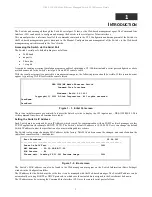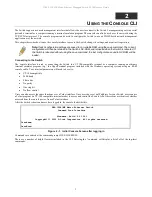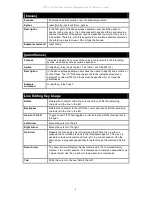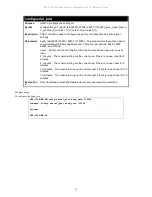
DES-1228/ME Metro Ethernet Managed Switch CLI Reference Guide
5
DES-1228/ME:5#config account
Command: config account
Next possible completions:
<username>
DES-1228/ME:5#config account
Command: config account
Next possible completions:
<username>
DES-1228/ME:5#
Figure 2 - 4. Using the Up Arrow to Re-enter a Command
In the above example, the command config account was entered without the required parameter <username>, the CLI returned the
Next possible completions: <username> prompt. The up arrow cursor control key was pressed to re-enter the previous command
(config account) at the command prompt. Now the appropriate username can be entered and the config account command re-
executed.
All commands in the CLI function in this way. In addition, the syntax of the help prompts are the same as presented in this manual
−
angle brackets < > indicate a numerical value or character string, braces { } indicate optional parameters or a choice of
parameters, and brackets [ ] indicate required parameters.
If a command is entered that is unrecognized by the CLI, the top-level commands will be displayed under the Available
commands: prompt.
DES-1228/ME:5#the
Available commands:
.. ? cable_diag clear
config create delete dir
disable download enable login
logout ping reboot reset
save show smtp telnet
traceroute upload
DES-1228/ME:5#
Figure 2 - 5. The Next Available Commands Prompt
The top-level commands consist of commands such as show or config. Most of these commands require one or more parameters
to narrow the top-level command. This is equivalent to show what? or config what? Where the what? is the next parameter.
For example, if users enter the show command with no additional parameters, the CLI will then display all of the possible next
parameters.










































